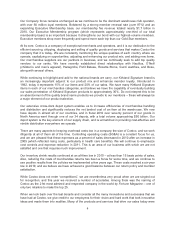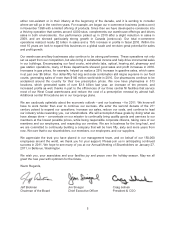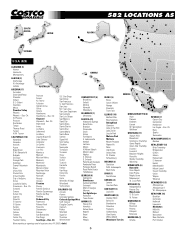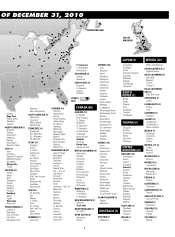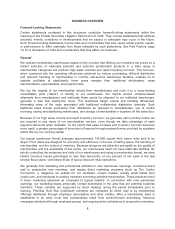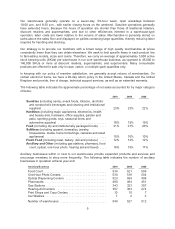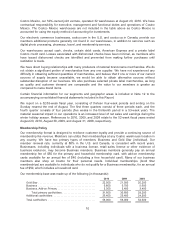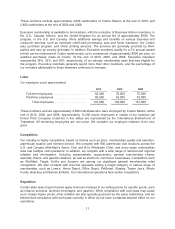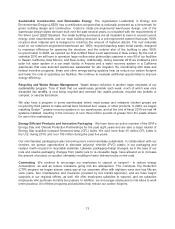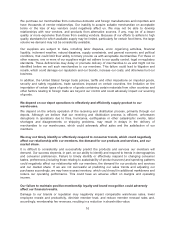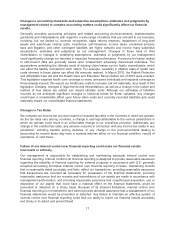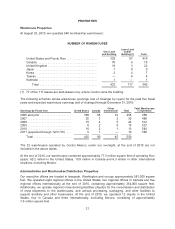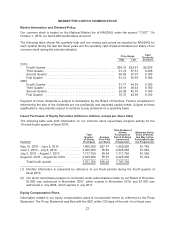Costco 2010 Annual Report Download - page 16
Download and view the complete annual report
Please find page 16 of the 2010 Costco annual report below. You can navigate through the pages in the report by either clicking on the pages listed below, or by using the keyword search tool below to find specific information within the annual report.RISK FACTORS
The risks described below could materially and adversely affect our business, financial condition, and
results of operations. These risks could cause our actual results to differ materially from our historical
experience and from results or events predicted by our forward-looking statements. Those statements
may relate to such matters as sales growth, increases in comparable store sales, cannibalization of
existing locations by new openings, price changes, earnings performance, earnings per share, stock-
based compensation expense, warehouse openings and closures, the effect of adopting certain
accounting standards, future financial reporting, financing, margins, return on invested capital, strategic
direction, expense control, membership renewal rates, shopping frequency, litigation impact and the
demand for our products and services. You should read these risk factors in conjunction with
Management’s Discussion and Analysis of Financial Condition and Results of Operations in Item 7 of
this Report and our consolidated financial statements and related notes in Item 8 of this Report. There
may be other factors that we cannot anticipate or that are not described in this report, generally
because we do not presently perceive them to be material, that could cause results to differ materially
from our expectations or statements. Forward-looking statements speak only as of the date they are
made, and we do not undertake to update these forward-looking statements. You are advised to review
any further disclosures we make on related subjects in our periodic filings with the SEC.
We face strong competition from other retailers and warehouse club operators, which could
negatively affect our financial performance.
The retail business is highly competitive. We compete for members, employees, sites, products and
services and in other important respects with many other local, regional and national retailers, both in the
United States and in foreign countries. We compete with other warehouse club operators, discount
retailers, supermarkets, supercenter stores, retail and wholesale grocers, department, drug, variety and
specialty stores and general merchandise wholesalers and distributors, as well as internet-based
retailers, wholesalers and catalog businesses. Such retailers and warehouse club operators compete in
a variety of ways, including merchandise pricing, selection and availability, services, location,
convenience, store hours, and price. Our inability to respond effectively to competitive pressures and
changes in the retail markets could negatively affect our financial performance. Some competitors may
have greater financial resources, better access to merchandise, and greater market penetration than we
do.
General economic factors, domestically and internationally, may adversely affect our financial
performance.
Higher interest rates, energy costs, inflation, levels of unemployment, healthcare costs, consumer debt
levels, unsettled financial markets, weaknesses in housing and real estate markets, reduced consumer
confidence, changes related to government fiscal and tax policies and other economic factors could
adversely affect demand for our products and services or require a change in the mix of products we
sell. Prices of certain commodity products, including gasoline and other food products, are historically
volatile and are subject to fluctuations arising from changes in domestic and international supply and
demand, labor costs, competition, market speculation, government regulations and periodic delays in
delivery. Rapid and significant changes in commodity prices may affect our sales and profit margins.
These factors can also increase our merchandise costs and/or selling, general and administrative
expenses, and otherwise adversely affect our operations and results. General economic conditions can
also be affected by the outbreak of war, acts of terrorism, or other significant national or international
events.
14


